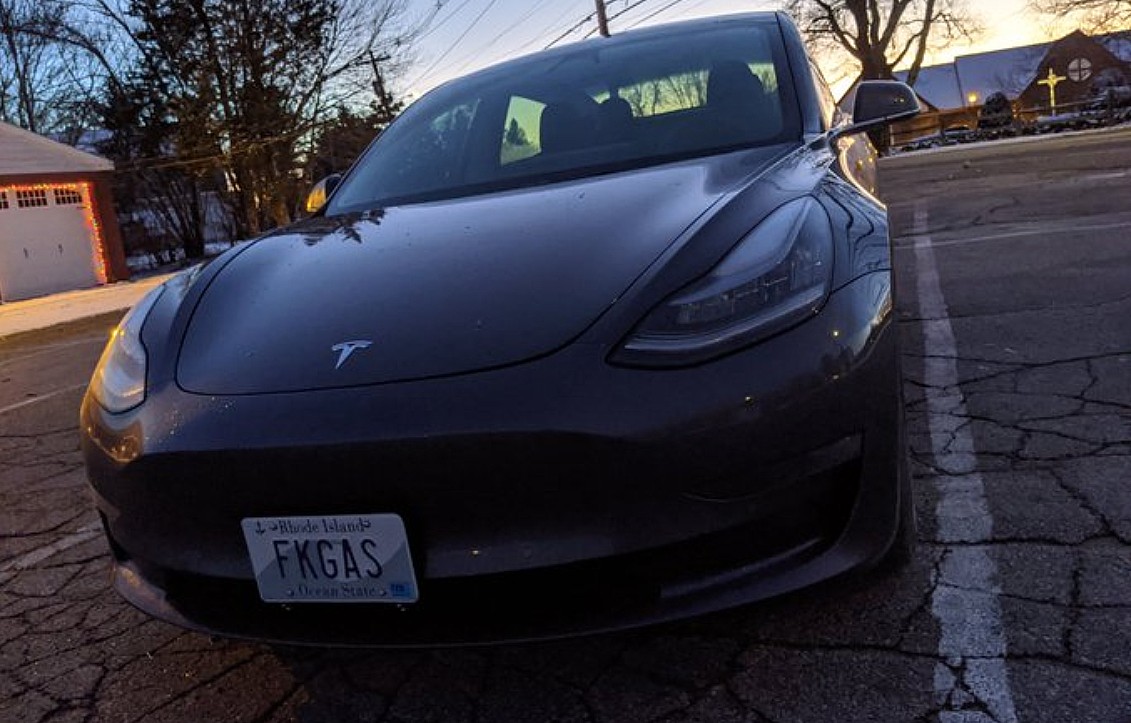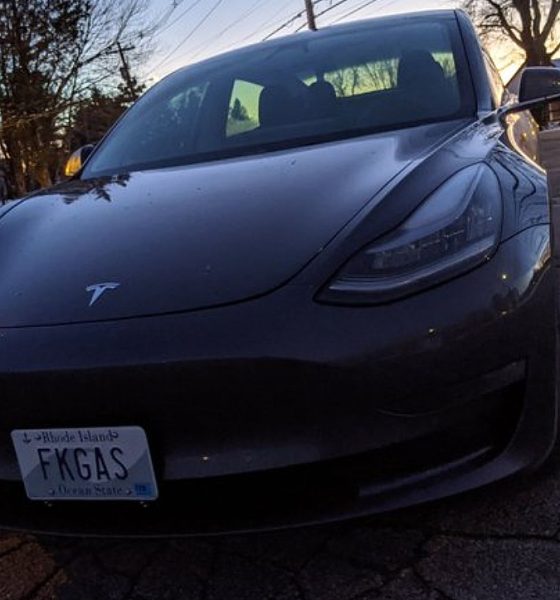

News
Tesla owner, ACLU win injunction against DMV in ‘offensive’ vanity plate dispute
A Tesla Model 3 owner won a preliminary injunction on Friday against the Rhode Island DMV in a dispute involving the use of a vanity plate displaying the message “FKGAS.” In response to an anonymous complaint earlier this year, the agency belatedly determined the messaging was offensive and that the plate must be returned. However, a lawsuit was filed in partnership with the state’s American Civil Liberties Union (ACLU) branch contesting the decision on constitutional grounds.
The “very essence of vanity plates is personal expression,” wrote U.S. District Judge Mary McElroy in the decision granting the injunction, agreeing that the lawsuit’s case was likely to succeed on the merits. “The revocation of the license plate, which would prohibit Mr. Carroll from expressing his views on fossil fuel propulsion of motor vehicles, would stifle him in an irreparable way.” The judge also suggested the overall authority of DMVs to reject “offensive” vanity plates was unconstitutional, according to a report on the case in the publication The Providence Journal.
This initial victory ensures that the owner, Sean Carroll, may continue displaying the vanity tag until a full case decision is made. “I am thrilled with Judge McElroy’s decision on my First Amendment right allowing me to express my views through my vanity plate,” Carroll said in a statement published by the Rhode Island ACLU. The Model 3 owner also acknowledged that, while the plate’s full translation was intended as “fake gas,” it could also be perceived as conveying the message “fuck gas,” a meaning he supported as well.
In a significant decision for free speech advocates and vanity plate enthusiasts alike, a federal judge said a Scituate man can keep the "FKGAS" plate on his Tesla for now. The RI DMV has tried to cancel it. https://t.co/WEogyg9EGZ
— Brian Amaral (@bamaral44) October 4, 2020
In the lawsuit, Carroll’s motivation for obtaining the vanity plate was “because he wished to convey, through the license plate, a personal philosophical and political message concerning his views about gasoline-powered automobiles and the environment.” He previously explained that the idea came after a conversation with his daughter during which he described how the all-electric vehicle was powered by their home’s solar panels. His daughter remarked that the car runs on “fake gas,” and thereby the “FKGAS” vanity plate was born.
“‘FKGAS’ is my personal statement challenging everyone to look at the world differently. Gas isn’t the only option when it comes to powering your vehicle,” Carroll said in a statement to The Providence Journal. “My choice for a vanity plate has already brought more attention to alternative fuel sources and electric vehicles.”
As another important part of Carroll’s case, the DMV already issued the Model 3’s plate twice before deciding to recall it, citing “inappropriate language.” The Tesla owner had driven with the message on his vehicle for at least five months before the agency reneged in response to an anonymous complaint. A key point of the arguments of the case filed with the ACLU was the arbitrary nature of the DMVs decision making process on vanity plates, ultimately pitting those decisions against first amendment protections such as Carroll’s views.
“[T]he DMV has prohibited such combinations as AIDS, CHRIST, GAY, JESUS, LESBIAN, REDNECK and YANKEE. But it has issued plates that read CHRIST, JEWISH, REDNEC, and REDNEK. It has prohibited words that are typically denigrating, such as CHUBBY and SLOB, but allowed FATT and OLDFRT,” Judge McElroy detailed in her decision.
The full lawsuit will be reviewed and decided in the coming months.

Elon Musk
Elon Musk’s X will start using a Tesla-like software update strategy
The initiative seems designed to accelerate updates to the social media platform, while maintaining maximum transparency.

Elon Musk’s social media platform X will adopt a Tesla-esque approach to software updates for its algorithm.
The initiative seems designed to accelerate updates to the social media platform, while maintaining maximum transparency.
X’s updates to its updates
As per Musk in a post on X, the social media company will be making a new algorithm to determine what organic and advertising posts are recommended to users. These updates would then be repeated every four weeks.
“We will make the new 𝕏 algorithm, including all code used to determine what organic and advertising posts are recommended to users, open source in 7 days. This will be repeated every 4 weeks, with comprehensive developer notes, to help you understand what changed,” Musk wrote in his post.
The initiative somewhat mirrors Tesla’s over-the-air update model, where vehicle software is regularly refined and pushed to users with detailed release notes. This should allow users to better understand the details of X’s every update and foster a healthy feedback loop for the social media platform.
xAI and X
X, formerly Twitter, has been acquired by Elon Musk’s artificial intelligence startup, xAI last year. Since then, xAI has seen a rapid rise in valuation. Following the company’s the company’s upsized $20 billion Series E funding round, estimates now suggest that xAI is worth tens about $230 to $235 billion. That’s several times larger than Tesla when Elon Musk received his controversial 2018 CEO Performance Award.
As per xAI, the Series E funding round attracted a diverse group of investors, including Valor Equity Partners, Stepstone Group, Fidelity Management & Research Company, Qatar Investment Authority, MGX, and Baron Capital Group, among others. Strategic partners NVIDIA and Cisco Investments also continued support for building the world’s largest GPU clusters.
News
Tesla FSD Supervised wins MotorTrend’s Best Driver Assistance Award
The decision marks a notable reversal for the publication from prior years, with judges citing major real-world improvements that pushed Tesla’s latest FSD software ahead of every competing ADAS system.

Tesla’s Full Self-Driving (Supervised) system has been named the best driver-assistance technology on the market, earning top honors at the 2026 MotorTrend Best Tech Awards.
The decision marks a notable reversal for the publication from prior years, with judges citing major real-world improvements that pushed Tesla’s latest FSD software ahead of every competing ADAS system. And it wasn’t even close.
MotorTrend reverses course
MotorTrend awarded Tesla FSD (Supervised) its 2026 Best Tech Driver Assistance title after extensive testing of the latest v14 software. The publication acknowledged that it had previously criticized earlier versions of FSD for erratic behavior and near-miss incidents, ultimately favoring rivals such as GM’s Super Cruise in earlier evaluations.
According to MotorTrend, the newest iteration of FSD resolved many of those shortcomings. Testers said v14 showed far smoother behavior in complex urban scenarios, including unprotected left turns, traffic circles, emergency vehicles, and dense city streets. While the system still requires constant driver supervision, judges concluded that no other advanced driver-assistance system currently matches its breadth of capability.
Unlike rival systems that rely on combinations of cameras, radar, lidar, and mapped highways, Tesla’s FSD operates using a camera-only approach and is capable of driving on city streets, rural roads, and freeways. MotorTrend stated that pure utility, the ability to handle nearly all road types, ultimately separated FSD from competitors like Ford BlueCruise, GM Super Cruise, and BMW’s Highway Assistant.
High cost and high capability
MotorTrend also addressed FSD’s pricing, which remains significantly higher than rival systems. Tesla currently charges $8,000 for a one-time purchase or $99 per month for a subscription, compared with far lower upfront and subscription costs from other automakers. The publication noted that the premium is justified given FSD’s unmatched scope and continuous software evolution.
Safety remained a central focus of the evaluation. While testers reported collision-free operation over thousands of miles, they noted ongoing concerns around FSD’s configurable driving modes, including options that allow aggressive driving and speeds beyond posted limits. MotorTrend emphasized that, like all Level 2 systems, FSD still depends on a fully attentive human driver at all times.
Despite those caveats, the publication concluded that Tesla’s rapid software progress fundamentally reshaped the competitive landscape. For drivers seeking the most capable hands-on driver-assistance system available today, MotorTrend concluded Tesla FSD (Supervised) now stands alone at the top.
News
Elon Musk’s Grokipedia surges to 5.6M articles, almost 79% of English Wikipedia
The explosive growth marks a major milestone for the AI-powered online encyclopedia, which was launched by Elon Musk’s xAI just months ago.

Elon Musk’s Grokipedia has grown to an impressive 5,615,201 articles as of today, closing in on 79% of the English Wikipedia’s current total of 7,119,376 articles.
The explosive growth marks a major milestone for the AI-powered online encyclopedia, which was launched by Elon Musk’s xAI just months ago. Needless to say, it would only be a matter of time before Grokipedia exceeds English Wikipedia in sheer volume.
Grokipedia’s rapid growth
xAI’s vision for Grokipedia emphasizes neutrality, while Grok’s reasoning capabilities allow for fast drafting and fact-checking. When Elon Musk announced the initiative in late September 2025, he noted that Grokipedia would be an improvement to Wikipedia because it would be designed to avoid bias.
At the time, Musk noted that Grokipedia “is a necessary step towards the xAI goal of understanding the Universe.”
Grokipedia was launched in late October, and while xAI was careful to list it only as Version 0.1 at the time, the online encyclopedia immediately earned praise. Wikipedia co-founder Larry Sanger highlighted the project’s innovative approach, noting how it leverages AI to fill knowledge gaps and enable rapid updates. Netizens also observed how Grokipedia tends to present articles in a more objective manner compared to Wikipedia, which is edited by humans.
Elon Musk’s ambitious plans
With 5,615,201 total articles, Grokipedia has now grown to almost 79% of English Wikipedia’s article base. This is incredibly quick, though Grokipedia remains text-only for now. xAI, for its part, has now updated the online encyclopedia’s iteration to v0.2.
Elon Musk has shared bold ideas for Grokipedia, including sending a record of the entire knowledge base to space as part of xAI’s mission to preserve and expand human understanding. At some point, Musk stated that Grokipedia will be renamed to Encyclopedia Galactica, and it will be sent to the cosmos.
“When Grokipedia is good enough (long way to go), we will change the name to Encyclopedia Galactica. It will be an open source distillation of all knowledge, including audio, images and video. Join xAI to help build the sci-fi version of the Library of Alexandria!” Musk wrote, adding in a later post that “Copies will be etched in stone and sent to the Moon, Mars and beyond. This time, it will not be lost.”








